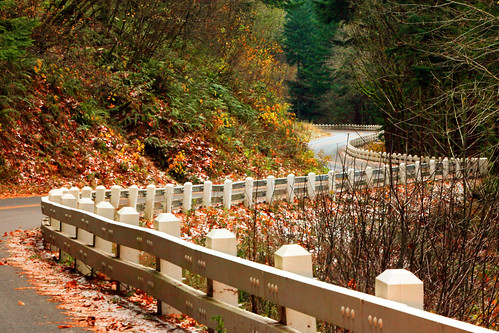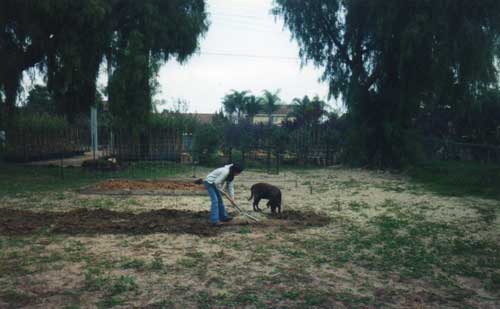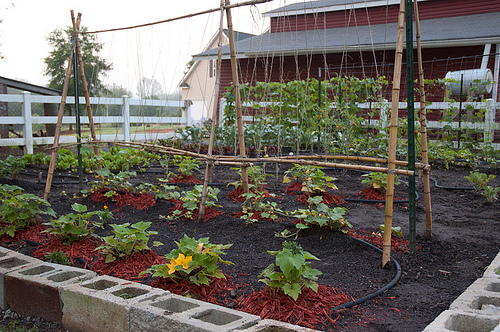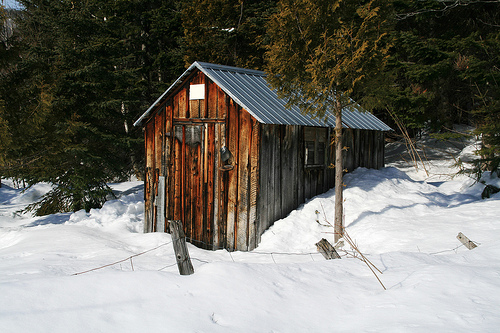Posts Tagged ‘Fruit Trees’
A Life Lived in Grace

This beginning of a New Year is like a bend in a winding mountain road. It fades in my rearview as we move farther and farther from its starting point. I’ve been reflecting lately on all that can be accomplished on a small suburban homestead such as ours and feeling rather – well – contented and secure.
On just a third of an acre we are able to raise lambs and chickens to put meat in our freezer and eggs for breakfast and baking. An extra lamb we butchered is being parceled out to friends and neighbors who don’t want a whole or half lamb. And, at $9 to $15 per pound for organic lamb, I think this may turn out to be a very good thing.
The broilers we raised from day old chicks were butchered last week. Our original plan was to butcher before Christmas, but the bad weather and family obligations forced us to push back a few weeks. With the extra time on feed most of the birds were in the 7 to 8 pound range, with a few pushing over 9 pounds. At those weights the birds are too big for a family of two, so most were cut in half and a few quartered, giving us enough chicken for about 30 weeks, assuming we eat chicken once a week. Not bad, folks! Not bad at all!
The hens are laying 5 to 7 eggs a day now, not quite at full stride yet, but, that’s 3-1/2 dozen a week, enough to keep us in omelets with a few dozen left over to sell to cover feed costs.
Our berries and fruit trees are coming into their own and give us plenty of fresh seasonal fruit for eating and a little extra for freezing or canning or cooking; the garden gives us plenty of greens and root vegetables; tomatoes and cucumbers; squash and pumpkins, even with the occasional crop failure.
Thanks to some great sales in November and December our pantry is brimming with staple goods. And, the added savings from coupons meant most were “free” or nearly “free”. It’s so nice to be able to just walk over, open a cupboard and pull out what you need for an evening meal. No treks to the store after dark. No drives during inclement weather.
We picked up another load of firewood from the grandparents’ place, our second of the winter. With the colder temperatures we are burning more wood than in years past and it’s a blessing to have such a ready source. Loading split wood on a cool afternoon makes for a robust workout. I love it.
I think these reflections were brought on by a morning news story on the inflationary period coming our way. Read the rest of the story »
Changes From Within
We are a small suburban homestead here—a few cloven hooves, a few mixed breed chickens, a rabbit, a garden with fruit trees and berry canes, and two wandering dogs.
The posts that hold the arbor fences also hold the laundry line. The lamb I roast for Sunday dinner is also the lamb that is chopped and sprinkled over kibble. The shells from the eggs I crack into omelets end up in the compost, and scraps of fresh salad greens and veggies are feasts for our feathered ones. So what was once waste, to be thrown into the trash, is now feed for future eggs or chicken salad or turned into garden soil. The system we have is simple, but it serves us well.
There is work yet to be done though; I’d like to have a greenhouse to extend our growing season, a pond with geese and Thanksgiving turkeys. But, for now there is a garden to turn and meat chicks to raise. There are the chores of switching from one season to another, lamb to sell, firewood to lie in and workshops to attend. Without really knowing how, it all seems to fall into place. It all, somehow, gets done.
As I think back on all we have accomplished, I realize that the real work of this farm is not the food we’ve grown or the skills we’ve learned: it’s us. I say this will all sincerity.
When you build a place into your life purpose it changes you; changes how you understand yourself. It humbles you, but not at the mercy of the main intention. There’s no room for ego when there’s a barn full of shit waiting to be shoveled. When I think back over how we have slowly turned an overgrown suburban lot into what we want it to be, I see confidence in who we are, strength in who Brianne will become, but also worries. I never used to think about Brianne going off on her own, wanting to make her own way. I know she wants her own place one day, but I think about how and where and when. I worry about tasks that are beyond my strength, being alone and having time to myself. Certain things subside over time, but some stay raw and exposed.
Maybe that’s just the growing part. Or, maybe this place is teaching me to mind my priorities and let logic win over emotion. I’m not quite sure. I do know one thing I’m happy in this life, feel at home on our little farm with the animals and home cooked meals. I can close my eyes, click my heels three times and settle in.
Perhaps we never really settle down into our lives. Maybe we just have to give our lives time to settle into us.
A Year in the Life of a Suburban Homestead
July
Ever since I was a little girl I have always enjoyed roses. Over the years and as my tastes have changed I find myself drawn more to the antique rose varieties than anything else. I love their fragrance and the look of them reminds me of quite days lived in country castles. I have dozens of David Austen roses around my place and during July they burst into bloom with an intoxicating perfume that hangs over the whole garden. The garden as a whole keeps use pretty busy during July. The weather is hotter and keeping things moist is a daily challenge. But, it’s also a time of great reward. Seeds and transplants started earlier in the year now bear constantly.
First tomatoes come off around Fourth of July
More direct sown seeds planted
Water daily
Weed and mulch as needed
Spent veggies fed to chickens
Mid-season berries picked, eaten fresh and frozen for winter
Peach harvest continues
Peaches canned and frozen
Beans canned and frozen
Pickled beets canned
Herbs dried
Preparations made and animals groomed for State Fair
Attend and show at State Fair
August
Our family has shown at the county fair for more than 30-years. Now it’s Brianne’s turn. She loves hanging out in the barn visiting with friends while grooming her sheep. I love watching her grow with each passing year. She and her friends are fiercely competitive inside the show ring, but outside they are just a bunch of giggly silly teenagers. It’s so much fun to watch. August is a hard time to be away from the homestead, so much is going on this month. But, I have wonderful neighbors who feed animals and water gardens. Secretly, I think they like when we’re gone because they get paid in free range eggs and fresh produce.
Weeding and watering are our life
Tomatoes harvested daily; frozen for future processing
Other veggies harvested; what can’t be processed is frozen for later time
Onions braided and hung to dry
Fruit trees and berries fed
Turkeys butchered and wrapped for freezer
Preparations made and animals groomed for County Fair
Attend and show at County Fair
Left over fair lambs sold or butchered
Broiler chicks arrive end of month
September
With fairs over and prizes displayed, our mind turns to school. Brianne actually starts school the last week of August, but with our busy schedule we are never prepared. The bulk of the shopping takes place on Labor Day weekend – usually the hottest weekend of the month. The homestead seems quiet this time of year, with most of the animals gone. Only the broiler chickens remain, but they are easy to care for. The garden seems to rebound in September, as late spring and summer plantings come off, fall plantings of onions, garlic and root vegetables take their place. We even get a glimpse of our future squash and pumpkin harvest.
Dried beans harvested, vines given to chickens
Zucchini, patty pan, crookneck and other squash harvested
Zucchini relish canned
Broilers butchered at 4-weeks (Cornish game hen size)
Lay in firewood for a warm winter
Clean trailer and store for winter; bedding used in chicken coop as winter bedding
All livestock equipment cleaned, oiled and stored for winter
Shearing blades sent to be re-sharpened
Show blankets repaired and stored
![]() photo credit: andrewodom
photo credit: andrewodom
Farm Census
I was thinking about the census the other day, and thought it would be interesting (for you all) to read a census of my little homestead. I’m a huge proponent of doing what you can where you can. No matter how big or how small you think you’re place is there is always room for a bit of self-sufficiency.
Homestead Census 2010
5 – lambs
18 – chickens
1 – rabbit
6 – blueberries
7 – berries (1 black, 1 Logan, 1 red rasp, 4 yellow rasp)
6 – fruit trees
8 – 4’x8’ raised veggie beds
3 – 8’x10’ raised beds
2 – mangy mutts (just kidding)
1 – active kid, and
1 – tired mom
Take the First Step

I found this photo from the first year here on our little suburban homestead. It was taken after my friend Rouge came over to grade and level the property, making the water drain properly. We had already removed about a dozen old, scraggy, ill cared for fruit trees that were planted haphazardly around the property, mangy Oleander bushes and a row of boxwood hedge that divided the property in half.
The photo is nothing special, just Brianne helping trench the barn waterline, raised beds and stakes outlining the footprint of the barn. But what it has lead to is six years of a working, prosperous backyard farm. In just a few years after this photo was taken we have built the barn (by hand) that now houses our livestock, planted gardens, bred rabbits, raised sheep, kept chickens, lived with mutts (Dakota and Dutch), danced to music at sunset, raised a kid and fell in love with the simpler things in life.
There were many times I had no idea what the hell I was doing; I taught myself as I went along, reading books in Borders over a steaming bowl of soup at lunch. I scoured the internet for forums of like-minded people. I joined clubs, made new friends, tapped old ones for information and techniques. We learned to eat from dirt and farm stands. We mostly eat at home now, but we go out to get what we need; out to the garden that is, to pick veggies and fruit and eggs. I can quilt now, build what I need, bake our own bread and sit down to share it all with you. But, the point I want to make is that things grew from the first small effort, and with steps taken it will bring you home.
Here we are today, with a freezer full of home grown lamb and chicken, handmade sausage and salami, berries, tomatoes, beans and peas. We get almost a dozen eggs a day. We’ve just hatched our own chicks – again. I know how to butcher a chicken from first cut to final wrap. I’m learning to collect rain water. Every year we learn and grow, becoming more self-sufficient thanks to this land.
A lot can happen if you make it. And it all starts somewhere. As the saying goes, “the journey of a thousand miles begins with the first step”. If you need proof, just look at the picture again. What was once barren, dry, and brown is lush and green and fruitful.
Make today the beginning of your journey. Just take that first step.
Fall Homesteading Chores
As summer fades in many parts of the country and trees start to show their brilliant fall colors, our minds turn to preparing for a change of seasons. Autumn is a favorite time for most – long walks spent admiring nature’s glory gives way to reflecting on what has passed in the summer just gone and what is yet to come with the approaching winter.
No matter where you live there are always chores and preparations to be made for the coming fall and winter months. The list below is just a sampling of the kinds of things you should be thinking about to ready your suburban homestead for the coming months.
(This is by no means a complete list, as different parts of the country have different requirements, but a way of getting you thinking about the cycle of a homestead and how a homestead’s activities are affected by the seasons.)
In the Garden
Gather fall leaves to feed your compost pile, or pile them around plants that are less cold tolerant to help keep them warm during the winter. Even pine boughs can be used to lessen the damage from freezing and thawing temperatures.
If your garden is new or limited in selection, take advantage of seasonal fruits and vegetables for canning and freezing.
Pick and store beans that have dried on the vine. Even small amounts can be used to enliven soups and stews, or made into small pots of baked beans. Any beans not picked young and at their peak can be left to dry on the vine.
Trim vines and berry canes of debris and dead canes. Cover with mulch or straw.
Pull up, clean and store garden trellises, stakes and tomato cages.
Cut back spent perennials and lightly prune fruit trees, removing broken branches.
Pull all dead and dying annuals; chop and add to compost.
Plant garlic for a wonderful spring harvest.
In temperate areas, cool weather crops with short growing times can still be planted.
Rake and lightly till garden areas. Add compost, leaves or mulch to enrich the soil over the winter.
Clean, repair and store gardening tools.
Clean and store rototillers and cultivators.
Clean, repair and prepare cold frames for planting cool weather crops.
In the Barn
To extend your egg production, set up lights in the chicken coop to give hens the illusion of longer days. Simple, inexpensive timers can also be installed to automatically turn lights off. If freezing is a problem, set up heat lamps over water troughs to keep water thawed.
Final batches of meat chickens should be ordered so they finish off before the weather turns too cold.
Put down thick layer, 3 to 4-inches, of litter (straw, shavings, leaves, etc) in chicken coop for winter bedding. Don’t forget nesting boxes.
Enclose rabbit hutches or move to a protected area to protect against cold winds, rain and snow.
Wrap pipes, especially in the garden, chicken coop and outbuildings, to prevent bursting from freezing weather.
Check all livestock supplies and reorder if necessary. Pay special attention to supplies needed for newborns.
Check lighting and repair or replace bulbs for winter use.
Administer any seasonal booster shots or vaccinations.
Around the House
Make sure alternate power sources, like generators are in good working order.
Relocate outdoor clothes lines to more accessible indoor locations like basements or garages.
Lay in a supply of firewood to take the chill off early fall temps and to augment the use of your furnace.
Air out cold weather bedding like wool blankets and down comforters.
Check weather stripping and replace or add where needed.
Store garden and lawn furniture and BBQ’s so cold winter temperatures don’t cause damage.
Inspect any equipment used in winter, like snow blowers or snow plows and service if needed.
Review household expenses for services or regular purchases you seldom use – then cancel or alter contracts or monthly plans to fit your budget. Make sure plans have not been altered or prices raised without your notice, causing you to pay more.
Fall is a great time to start the de-cluttering process. Choose one cabinet, closet or drawer per week to clean out and organize. Donate cast-offs to charity or plan a garage sale.
In the kitchen: Rotate stockpiled food items, especially canned foods, bottled water and emergency supplies.
Update family phone lists and emergency information. Include any new work, school, family or neighbor information.
In the Kitchen
If you live in an area that is prone to harsh winters with power outages, school and road closures, stock up on staples and enough food to last several days to a week. Don’t forget about pet and livestock feed as well. Running to the grocery or feed store may not be an option if the weather gets really bad.
Clean and reorganize freezer in preparation for fall harvests.
As a homesteader, autumn gives us time to assess what has worked in our quest to be self-reliant and what may still need our attention. It also gives us a break from the constant list of chores to plan, start new projects, or learn new skills.
Enjoy this time of year; pour over every new seed and livestock catalog that arrives in the mail; dream beyond all imagine, before you have to stop yourself, take a deep breath and reexamine every aspect of your overall homesteading plan.
A great way to remind your self of seasonal chores is to make a chart of what you want (or need) to accomplish in any given season. That way you can “check-off” completed projects while still being reminded of those yet to finish. Keep your chart handy on an Excel spreadsheet so you can add to it.



Recent comments
Aenean nonummy hendrerit mauris. Phasellus porta.